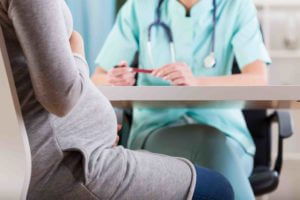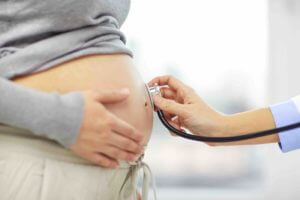About 80 percent of all expectant mothers get the note “high-risk pregnancy” entered in their maternity passport. Why is that? At what point is a pregnancy considered high-risk?
Here you will find the most important information about high-risk pregnancies.
Table of contents
What Is A High-Risk Pregnancy?
Even with the best possible medical care, there is a certain residual risk in every pregnancy. However, if this is much more drastic than normal for mother or child, it is called a high-risk pregnancy. Whether or not there is a risk of a high-risk pregnancy is determined by a classification based on the results of preventive examinations. Even the slightest hint of information about high-risk pregnancies is noted in the mother’s passport. Although the complications do not necessarily occur, they serve as a note for doctors to ensure the best possible care. Depending on the initial situation, a high-risk pregnancy requires special diagnostic or even therapeutic measures.
What Does A High-Risk Pregnancy Mean?
Approximately 20 percent of all pregnancies are classified as high-risk. However, this does not automatically mean that there is a risk for you and your child. The term “high-risk pregnancy” sounds dramatic at first, but complications do not necessarily arise. If a pregnancy is classified as a risk, this initially only means that the pregnant woman must be observed particularly intensively. Hard to believe – but fact: Only one in five women carries their child to term without a note in the maternity record indicating a risk pregnancy.
Information About High-Risk Pregnancies: General Criteria
Possible risks that may indicate possible complications during pregnancy can be derived from the medical history or from the lifestyle of the pregnant woman.
If even one of the listed criteria is met, a note is already entered in the maternity record.
- The pregnant woman is under the age of 20 or over the age of 35.
- Problematic history of previous pregnancies or births, such as premature birth, miscarriage, or cesarean delivery.
- Multiple pregnancy.
- Threatened premature birth.
- Exceeding the due date.
- Medical conditions such as diabetes, asthma, hepatitis, epilepsy, heart disease, high blood pressure, Crohn’s disease and ulcerative colitis, severe mental illness, infections or thyroid disease.
- Hereditary diseases in the family.
- Smoking or alcohol consumption.
- Use of medications.
What Role Does Age Play?
The lowest risk of pregnancy affects women between the ages of 20 and 29. If the expectant mother is under 20 or older than 35, she is affected by a higher probability that she and her child could potentially be at risk during pregnancy.
Pregnant Women Under 20
If the pregnant woman is younger than 20, she is more likely to suffer from preterm labor. Pregnancy toxicity, deficiency development or premature birth could also occur. However, with careful and adequate medical monitoring, even very young mothers need not worry unduly.
Pregnant Women Over 35
The birth rate of women between the ages of 35 and 39 is higher today than it was twenty years ago. However, a late pregnancy also brings some advantages: experience, serenity, stable partnership as well as a mostly stable financial background. However, one must also expect higher risks or complications with pregnancies at this age. For example, women over 35 are more likely to have premature births or miscarriages, or to give birth by cesarean section. In addition, the child may possibly suffer from chromosomal abnormalities such as trisomy 21.
Pregnant At 45 Or More
Of course, the risks also increase with age. However, with good medical care and monitoring, it is possible to make the pregnancy comfortable for both mother and baby.
Physical Indications Of A High-Risk Pregnancy
A physical examination can already provide initial information about a high-risk pregnancy. For example, smaller women, i.e. under 1.50 meters, tend to have a disturbed birth process due to a smaller pelvic outlet. In underweight women, the unborn baby may be deficient or undersupplied. Overweight women, on the other hand, may affect the sale of pregnancy due to existing diabetes or pregnancy toxicity. In addition, obesity in itself can also be a factor in making the birth process more difficult or slowing down labor. Chronic high blood pressure additionally increases the danger of premature birth. Circulatory problems can lead to blockage of the blood vessels. If the doctor also performs a gynecological examination, he or she can infer any risks during pregnancy based on benign growths in the uterus, changes in the cervix or malformations of the uterus. Infections or inflammations in the genital area can also affect pregnancy, as well as the position of the baby in the mother’s abdomen.
How Do I Deal With It If A Risk Pregnancy Is Noted In My Maternity Record?
Very important: don’t let it scare you! As already mentioned, doctors will note a high-risk pregnancy at the slightest hint. However, this note alone does not indicate that complications will occur, but is merely an indication for the best possible medical examination and monitoring.
The Following Is Important For You:
You Decide How Many Examinations You Want To Allow
This is about your body and your child’s body. Of course, it is important to visit your doctor regularly, but you can also decide what is necessary and what is not.
Trust Your Body
Your body does not experience pregnancy all the time, but it knows how to handle it. Medical care can give your body additional support.
Find The Doctor You Trust
A doctor should not only check off medical findings, but also care for you mentally during pregnancy to take away any fears you may have.
High-Risk Pregnancy – Who Covers The Costs?
Don’t worry! In principle, your health insurance will pay for the three preventive examinations. However, these only concern ultrasound examinations. Their aim is to detect and monitor the risks of pregnancy at an early stage. However, if there is a clear risk of pregnancy, further examinations are also covered by the health insurance. These include further ultrasound examinations, amniocentesis or cardiotocography. However, you must clearly agree to these examinations after your doctor has informed you about the purpose, procedure and meaning of the examination.
Information About High-Risk Pregnancies: Where Does The Term Come From?
Originally, the idea behind the questionnaire was to identify possible pregnancy risks.
In this case, the doctor categorizes the pregnant women according to medical care. According to this, he divides the pregnant women into those who receive the normal preventive care and the higher-risk cases that require special medical monitoring.
Sources:
https://www.netdoktor.de/schwangerschaft/risikoschwangerschaft/
https://www.eltern.de/schwangerschaft/gesundheit-und-fitness/risikoschwangerschaft.html
https://www.9monate.de/schwangerschaft-geburt/schwangerschaft/risikoschwangerschaft-id94153.html













3 thoughts on “Info About High-Risk Pregnancies – What You Should Know”